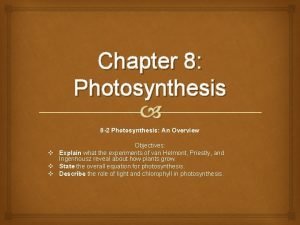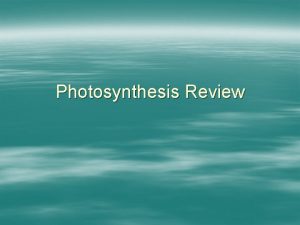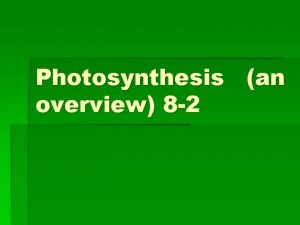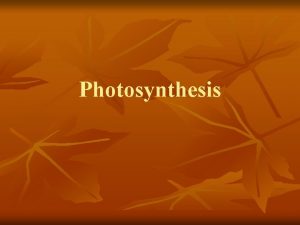Chapter 8 Photosynthesis 8 2 Photosynthesis An Overview











- Slides: 11

Chapter 8: Photosynthesis 8 -2 Photosynthesis: An Overview v v v Objectives: Explain what the experiments of van Helmont, Priestly, and Ingenhousz reveal about how plants grow. State the overall equation for photosynthesis. Describe the role of light and chlorophyll in photosynthesis.

Photosynthesis The key cellular process identified with energy production is photosynthesis. In the process of photosynthesis, plants use the energy of sunlight to convert water and carbon dioxide into high energy carbohydrates – sugars and starches – and oxygen, a waste product.

Investigating Photosynthesis Van Helmont’s Experiment Devised an experiment to find out if plants grew by taking material out of the soil. Determined the mass of a pot of dry soil and a small seedling. Planted the seedling in the pot of soil and watered it regularly. Weighed the seedling, now a small tree, at the end of five years and it had gained 75 kg The mass of the soil did not change. Conclusion: Most of the gain in mass had come from water. What he did not realize? Carbon dioxide in the air made a major contribution to the mass of his tree.

Investigating Photosynthesis Priestley’s Experiment: Took a candle Placed a glass jar over it Watched as the flame gradually died out Conclusion: Oxygen was necessary to keep a candle flame burning. Experiment #2: Placed a live sprig of mint under the jar Allowed a few days to pass The candle could be relighted and would remain lighted for a while The mint plant released the oxygen required for burning

Investigating Photosynthesis Jan Ingenhousz Showed that the effect observed by Priestley occurred only when the plant was exposed to light. The results of both Priestly’s and Ingenhousz’s experiments showed that light is necessary for plants to produce oxygen. The experiments performed by van Helmont, Priestly, and Ingenhousz led to work by other scientists who finally discovered that in the presence of light, plants transform carbon dioxide and water into carbohydrates, and they also release oxygen.

The Photosynthesis Equation 6 CO 2 + 6 H 2 O light carbon dioxide + water C 6 H 12 O 6 + 6 O 2 light sugars + oxygen Photosynthesis uses the energy of sunlight to convert water and carbon dioxide into high-energy sugars and oxygen.

Light and Pigments In addition of water and carbon dioxide, photosynthesis requires light and chlorophyll, a molecule in chloroplasts. Plants gather the sun’s energy with light-absorbing molecules called pigments. The plants’ principal pigment is chlorophyll. Two main types: Chlorophyll a Chlorophyll b

Light and Pigments

Light and Pigments What the graph shows: Chlorophyll absorbs light very well in the blue-violet and regions of the visible spectrum. Chlorophyll does not absorb light well in the green region of the spectrum. Green light is reflected by leaves, which is why plants look green.

8 -2 Section Assessment 1. What did van Helmont, Priestley, and Ingenhousz discover about plants? 2. Describe the process of photosynthesis, including the reactants and products. 3. Why are light and chlorophyll needed for photosynthesis? 4. Describe the relationship between chlorophyll and the color of plants.

8 -1 Section Assessment Answers 1. Van Helmont discovered that water was in increasing the mass of a plant. Priestly discovered that a plant produces the substance in air required for burning. Ingenhousz discovered that light is necessary for plants to produce oxygen 2. Photosynthesis uses the energy of sunlight to convert water and carbon dioxide into oxygen and high-energy sugars. 3. Light provides the energy needed to produce high-energy sugars. Chlorophyll absorbs light, and the energy of that absorbed light makes photosynthesis work. 4. Plants are green because green light is reflected by the chlorophyll in leaves.
 Chapter 9 lesson 2 photosynthesis an overview
Chapter 9 lesson 2 photosynthesis an overview 8-2 photosynthesis an overview
8-2 photosynthesis an overview Emt chapter 24 trauma overview
Emt chapter 24 trauma overview Chapter 14 medical overview
Chapter 14 medical overview Chapter 12 selling overview
Chapter 12 selling overview Financial intermediaries
Financial intermediaries Chapter 1 overview of verb tenses
Chapter 1 overview of verb tenses Overview of personal finance chapter 1
Overview of personal finance chapter 1 Overview of the dentitions chapter 11
Overview of the dentitions chapter 11 Foundations in personal finance answers chapter 1
Foundations in personal finance answers chapter 1 Chapter 32 an overview of animal diversity
Chapter 32 an overview of animal diversity Chapter 1 an overview of financial management
Chapter 1 an overview of financial management





















